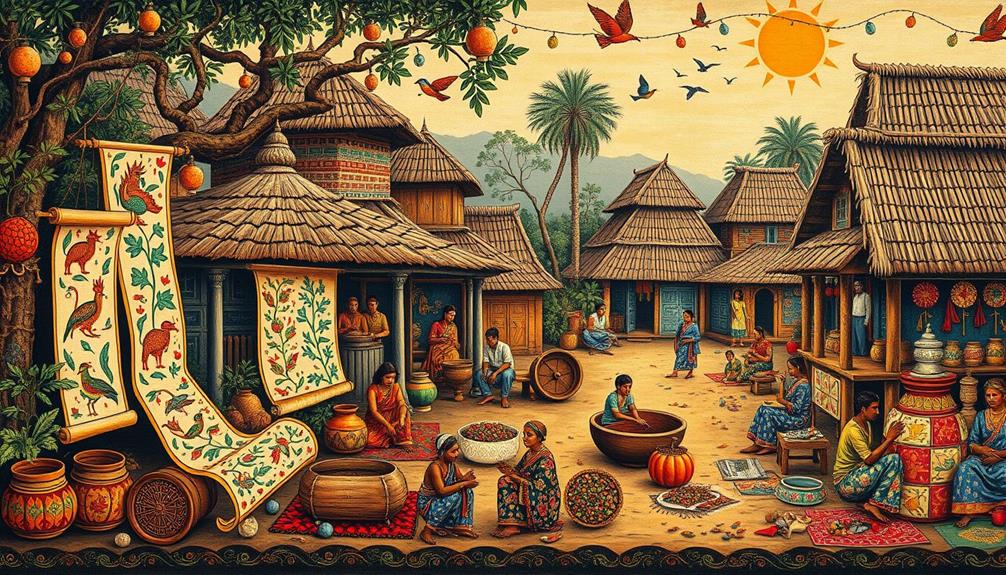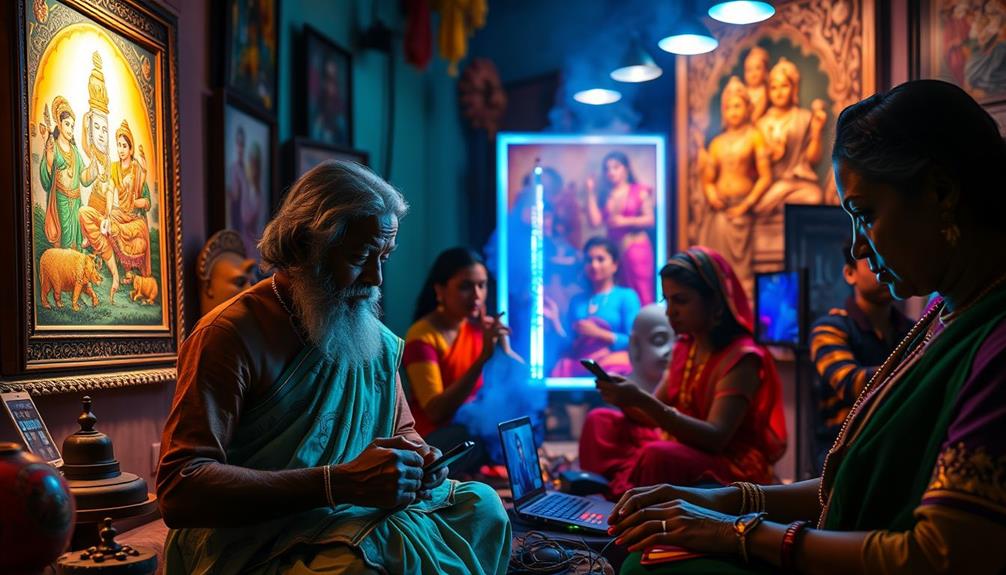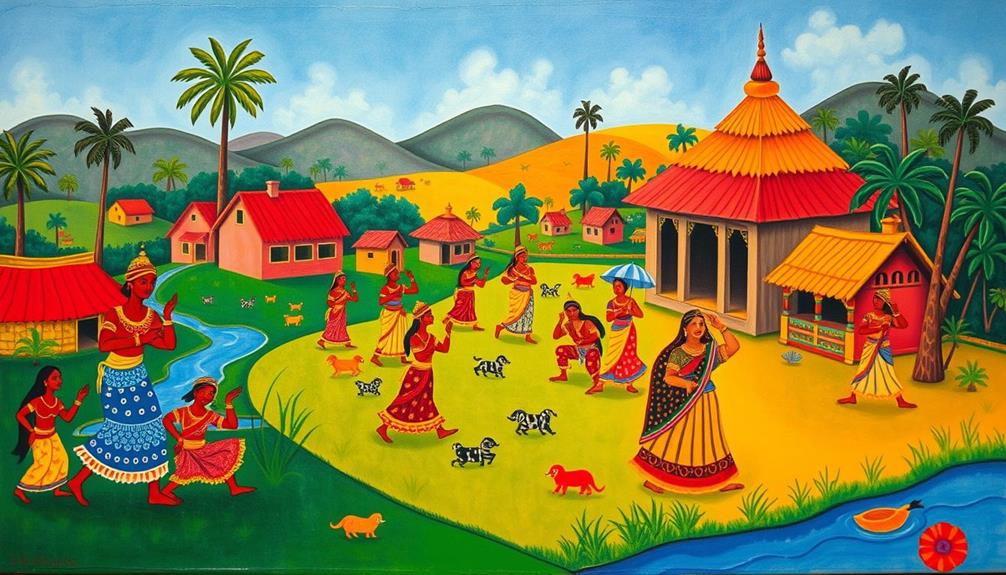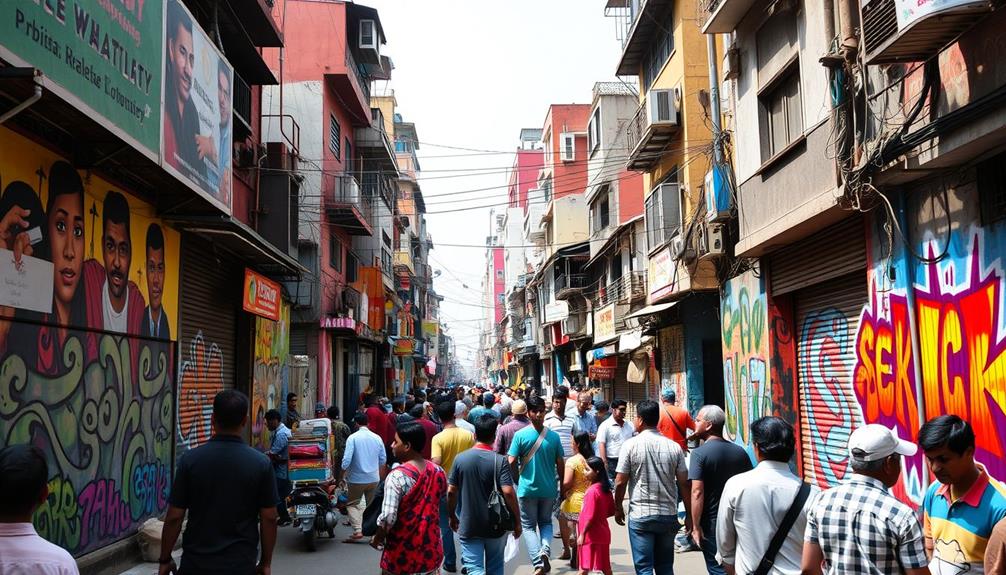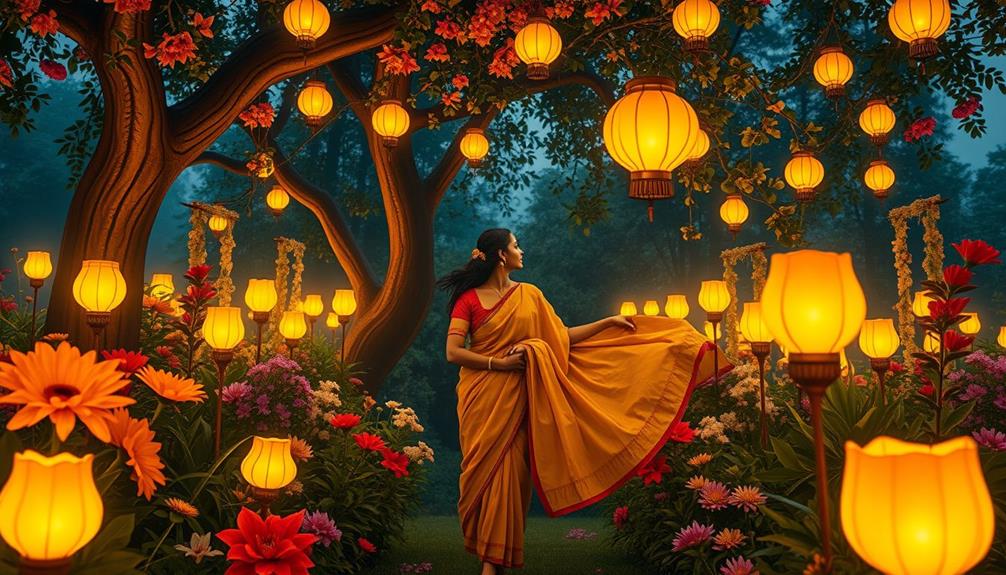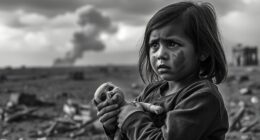The Bengal Pattachitra tradition, rooted in the 13th century, invites you into a world where storytelling merges with art. This vibrant form features scrolls adorned with intricate designs that express themes from Hindu mythology to contemporary social issues. Using natural dyes and traditional techniques, skilled artisans create emotionally resonant pieces. The Patua community plays a vital role, preserving these narratives through performance and visual art. As you explore this tradition, you'll find its significance in cultural identity and economic growth. Discover how it adapts to modern challenges and engages global audiences, shaping its future in today's world.
Key Takeaways
- Bengal Pattachitra, originating from the 13th century, combines visual art and storytelling, primarily depicting Hindu deities and folklore.
- The art form utilizes natural dyes and traditional techniques, resulting in vibrant, detailed paintings on cloth.
- Pattachitra artists, primarily from the Patua community, address contemporary themes like women's rights and environmental issues through their work.
- Economic significance has grown, with artists benefiting from increased demand and online platforms, yet they face challenges from modern entertainment and financial instability.
- Preservation efforts include workshops, exhibitions, and government support programs aimed at maintaining traditional skills and promoting cultural heritage.
Historical Roots
The Bengal Pattachitra tradition has deep historical roots, tracing back to the 13th century in the regions of West Bengal and Bangladesh. Initially, these vibrant artworks served as visual aids for itinerant storytellers and singers, bringing tales to life through enchanting imagery. The term "Pattachitra" itself comes from Sanskrit, where "patta" means cloth and "chitra" means picture, highlighting its traditional medium. This art form, much like BPD-coded characters, often reflects intense emotional experiences and provides a lens for understanding complex narratives.
Early Pattachitra pieces were painted on cloth or dried leaves, depicting themes centered around Hindu deities. Over time, the subject matter expanded, incorporating both secular and contemporary issues. This evolution reflects the dynamic nature of the tradition, allowing it to resonate with changing societal contexts.
Central to this tradition is the Patua community, a group of artists who traveled with painted scrolls, merging visual art and performance to narrate stories. Their role was essential in keeping the art form alive and relevant, as they adapted their narratives to engage audiences.
With historical references dating back to the medieval period and tangible evidence surfacing in the 18th century CE, Pattachitra stands as a proof of Bengal's rich cultural heritage and artistic legacy.
Artistic Techniques
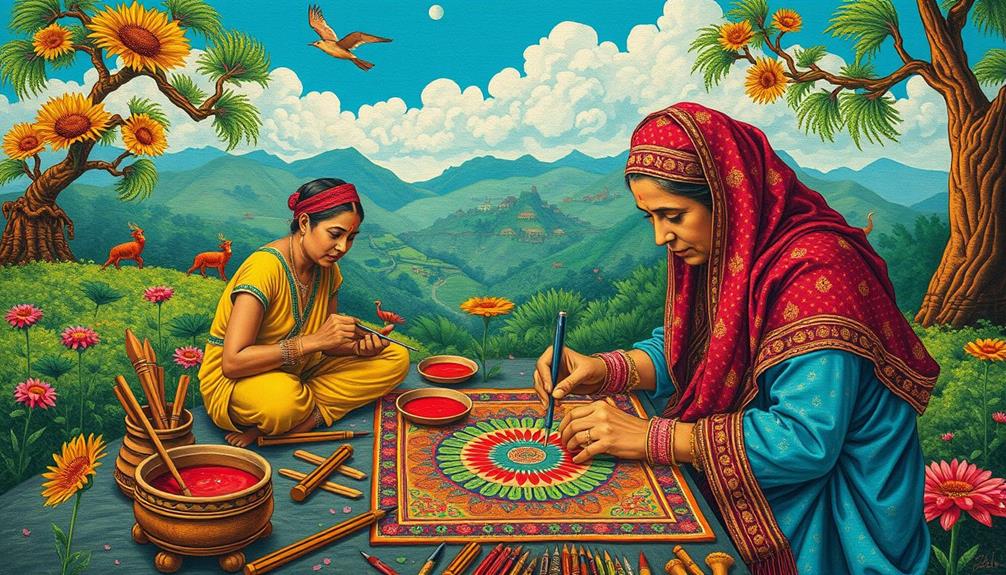
Creativity flows through the Bengal Pattachitra tradition, where artists employ a range of intricate techniques to bring their vibrant stories to life. The artistic process begins with preparing a durable canvas, often using layers of cotton cloth or old saris that are sun-dried. This careful preparation sets the stage for the stunning Pattachitra paintings that follow.
Artists also embrace the use of aromatic elements, which can enhance focus and creativity during the painting process, similar to how essential oils can support overall wellness.
Artists use natural dyes sourced from local ingredients, like turmeric for yellow hues, ensuring that the colors aren't only vibrant but also eco-friendly. The meticulous work continues as artists soak and grind these materials, often employing a fine brush made from a single goat hair for detailed designs. This precision allows for the creation of bold lines and intricate details that define the art form.
Pattachitra paintings come in two primary formats: the Jodano pata, long scrolls that tell stories, and the Chouko pata, single panels that stand alone as unique pieces. Each painting showcases stylized figures with elongated eyes, enhancing the emotional impact and visual narrative of the artwork.
Through these techniques, the essence of Bengal's rich storytelling tradition is beautifully captured.
Community and Cultural Impact
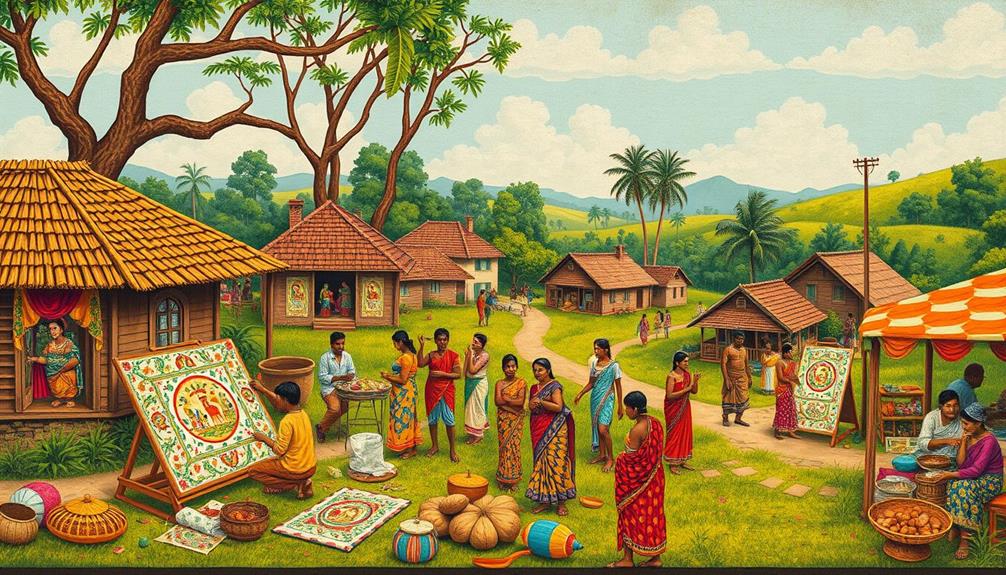
When you explore the role of the Patua community, you'll see how they've shaped storytelling through Pattachitra art.
This vibrant medium not only preserves cultural heritage but also engages the community in meaningful narratives.
By incorporating elements of creative expression, they enhance cognitive development and foster a sense of belonging.
Role of Patuas
Patuas serve as crucial custodians of the Bengal Pattachitra tradition, intertwining their Islamic heritage with rich Hindu customs to create a unique cultural tapestry. You'll find that these artists not only preserve history but also adapt their work to reflect contemporary themes and social issues. By narrating stories through vibrant scrolls, Patuas engage with audiences, emphasizing cultural identity and community values.
| Role of Patuas | Cultural Impact | Contemporary Themes |
|---|---|---|
| Custodians of Tradition | Reinforcing community values | Addressing women's rights |
| Itinerant Storytellers | Depicting local folklore | Highlighting environmental concerns |
| Educators & Entertainers | Fostering cultural identity | Engaging with modern issues |
| Adaptation of Art | Blending customs | Ensuring relevance today |
Through their storytelling, Patuas reflect both mythological and moral lessons, making their art a crucial educational tool in rural areas. Despite facing economic challenges, they continue to adapt, ensuring that their artistic expressions resonate with the evolving society, keeping the Bengal Pattachitra tradition alive and relevant.
Storytelling Through Art
Storytelling through art in the Bengal Pattachitra tradition is a vibrant expression of community and cultural identity. This unique art form, performed by Patuas, uses painted scrolls to narrate moral stories and mythological tales, weaving together the community's ethos and values.
With roots tracing back to the 13th century, Pattachitra has served as an essential medium for preserving local folklore and cultural heritage. Similar to how Aboriginal rock art serves as a historical record of life and beliefs, Pattachitra reflects the rich tapestry of Bengal's traditions.
During communal gatherings and festivals, the Patuas engage audiences through performances known as Pat Khelano. These performances blend visual and musical elements, creating a shared experience that fosters a sense of belonging.
Key aspects of this storytelling tradition include:
- Themes from Hindu epics like the Ramayana and Mahabharata
- Local legends that resonate with the community
- Contemporary issues such as women's rights and environmental conservation
Preservation of Heritage
For centuries, the Bengal Pattachitra tradition has been an essential thread in the fabric of community and cultural identity. The Patua community is at the heart of this preservation, sharing local folklore through their enchanting paintings and performances. You'll notice that various organizations, both government and non-government, actively support these efforts, conducting workshops and exhibitions to create market opportunities for Pattachitra artists.
Here's a quick overview of the impact of Pattachitra on community and culture:
| Aspect | Impact |
|---|---|
| Cultural Continuity | Reinforces traditional narratives |
| Community Engagement | Promotes participation among younger generations |
| Educational Value | Scrolls serve as tools for moral teachings |
| Economic Impact | Original pieces sell for ₹50,000 to ₹100,800, sustaining livelihoods |
Through these endeavors, Pattachitra not only reflects religious themes but also addresses contemporary social issues. Each scroll tells a story that enhances community ties, ensuring that the rich heritage of Bengal continues to thrive and resonate with future generations.
Themes and Iconography
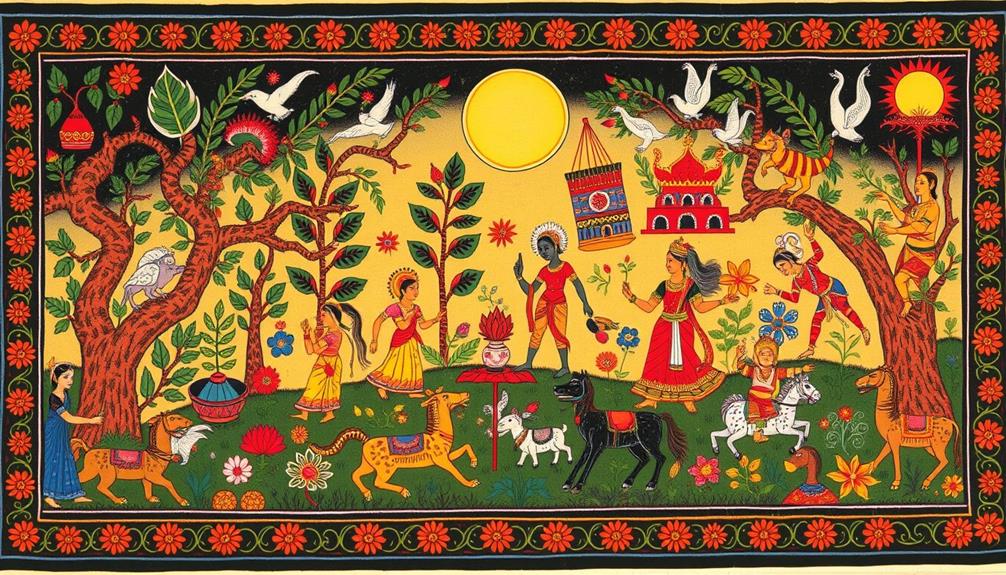
Bengal Pattachitra captivates with its rich themes and intricate iconography that draw profoundly from Hindu mythology and folklore. This art form serves as an essential connection to cultural narratives, inviting viewers to explore the stories of the past and present, and encouraging exploration of philosophical literature through its diverse representations.
You'll find that the art beautifully showcases a variety of deities and narratives, blending the spiritual with the social.
Key themes include:
- Divine Narratives: Central figures like Krishna, Kali, and Shiva are depicted alongside epic tales from the Ramayana and Mahabharata.
- Folklore Stories: Illustrations of traditional tales such as Mansha, Chandi, Behula, and Lakshinder convey moral and cultural lessons that resonate through generations.
- Contemporary Issues: Modern Pattachitra also tackles social themes, addressing women's rights, child rights, and environmental conservation.
The iconography in Bengal Pattachitra is truly distinctive, characterized by elaborate details, exaggerated facial expressions, and elongated eyes that enhance emotional depth.
The vibrant colors, derived from natural sources, create striking visual narratives. Pigments like Hingula (red) and Haritala (orange-yellow) help engage viewers, making each piece a conversation starter.
This fusion of themes and iconography not only preserves cultural heritage but also reflects the evolving societal landscape.
Economic Significance
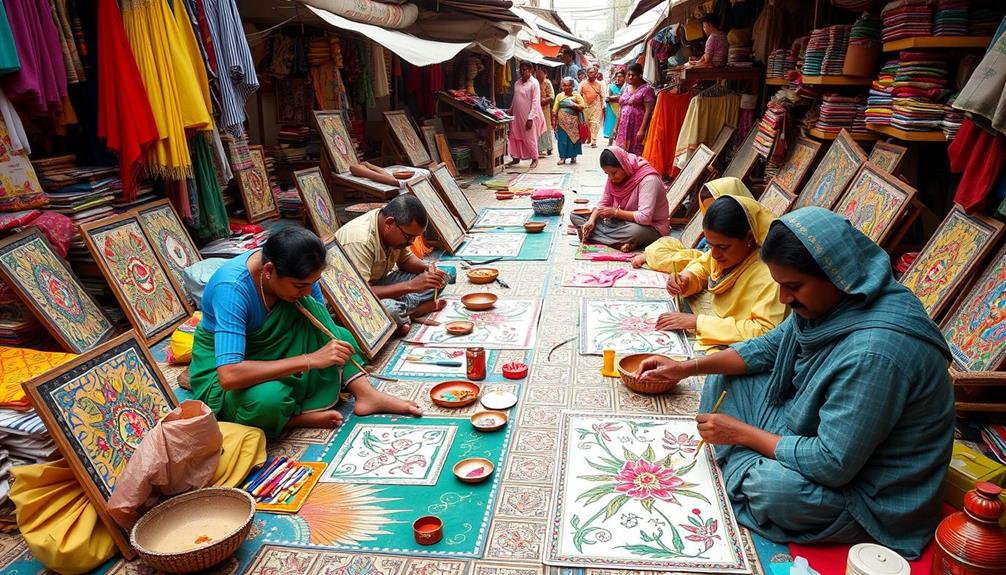
Over the years, the economic significance of Pattachitra art has steadily risen, making it an essential source of income for many artists in the region. This traditional art form has gained popularity in both domestic and international markets, with original pieces priced between ₹50,000 to ₹100,800 based on their complexity and detail.
As demand for Pattachitra art increases, it creates job opportunities for artists, enhancing their economic stability and livelihood. Additionally, much like gold investments, the value of Pattachitra art can provide a hedge against economic fluctuations, ensuring that artists can maintain their livelihoods even in challenging times.
Online platforms and marketplaces have further facilitated the sale and promotion of Pattachitra art, expanding its reach to a global audience. This accessibility not only benefits artists but also supports local economies, as increased sales attract tourism and cultural appreciation.
Government and NGO support has played a crucial role in preserving this craft, providing economic resources and promoting its cultural significance through various initiatives.
Contemporary Challenges

The rise in economic importance of Pattachitra art is bittersweet, as it coincides with contemporary challenges that threaten its survival. You'll notice that the traditional art form faces increasing competition from modern entertainment sources like smartphones and digital media, which distract people from appreciating Pattachitra painting. This shift has led many artists to abandon their craft for alternative jobs, risking the continuity of this cultural heritage.
The financial instability for artists mirrors the challenges faced by those in other creative fields, where reliable support and resources are essential for sustainability. Additionally, as seen in many service industries, the need for customizable cleaning plans can be likened to the need for artists to adapt to current trends while preserving their traditional techniques.
Consider these contemporary issues:
- The decline of traditional patron-client relationships has reduced financial support for artists.
- Economic pressures push artists away from Pattachitra, jeopardizing its practice and transmission.
- New themes in Pattachitra, focusing on social and political commentary, reveal an effort to stay relevant but highlight the struggle against evolving cultural landscapes.
As globalization sweeps through, many traditional songs and stories linked to Pattachitra have been lost, amplifying the need for urgent preservation efforts. Without them, the rich tapestry of Bengal's Pattachitra tradition may unravel, leading to a significant cultural loss.
It's essential to recognize these challenges to guarantee the survival and relevance of this beautiful art form.
Preservation Efforts
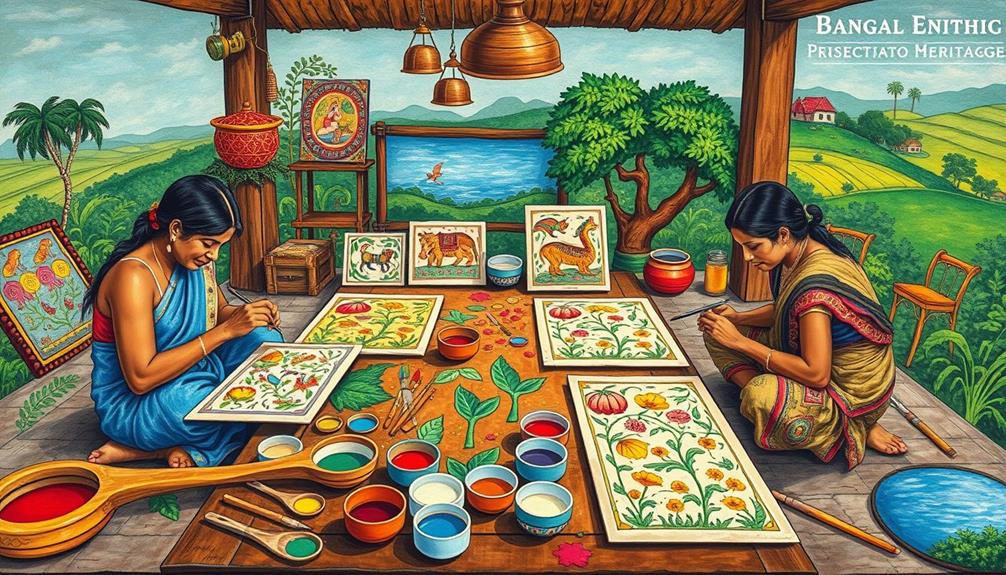
You'll find that community engagement initiatives play an essential role in preserving Bengal Pattachitra, connecting artists with local audiences.
These efforts not only foster a sense of belonging but also encourage the exploration of diverse dating platforms for collaboration among artists and patrons.
Government support programs also provide vital resources, helping to sustain the livelihoods of Patuas.
Together, these efforts create a vibrant ecosystem that guarantees this art form continues to thrive.
Community Engagement Initiatives
How can community engagement initiatives play an essential role in preserving the Bengal Pattachitra tradition? These initiatives foster a deeper connection to the art form, guaranteeing its survival and relevance. By actively involving local communities, they promote awareness and appreciation while enhancing preservation efforts.
Engaging communities can also draw inspiration from influential orators who connect with their audiences through storytelling, making the art form resonate on a personal level.
- Workshops and exhibitions organized by various organizations enable you to experience the art firsthand, creating a sense of ownership.
- Collaborations with cultural institutions provide platforms for artists to showcase their work, connecting them with broader audiences and improving their livelihoods.
- Training programs for younger generations guarantee traditional skills are passed down from established artists to aspiring Patuas, maintaining the art's authenticity.
Additionally, these community-based efforts adapt contemporary themes within Pattachitra, guaranteeing the art resonates with modern societal issues.
Government Support Programs
Numerous government support programs have emerged to bolster the preservation of Bengal Pattachitra art, ensuring its importance for future generations. These initiatives not only provide financial assistance to Patachitra artists but also promote traditional techniques through workshops. The "Geographical Indication" (GI) registration safeguards the authenticity of this art form, giving artists recognition and protection.
| Program Name | Purpose | Target Group |
|---|---|---|
| GI Registration | Protect authenticity and uniqueness | Patachitra artists |
| Financial Assistance | Support artists financially | Patachitra artists |
| Educational Initiatives | Integrate art into curricula | Young students |
| Skill Development | Create sustainable livelihoods | Patachitra artists |
Cultural organizations and governmental bodies host exhibitions and art fairs, providing Patachitra artists with platforms to reach wider audiences and gain significant financial support. Collaborations between NGOs and government agencies further enhance the skill development of artists, ensuring they have access to modern marketing avenues, including online platforms. These combined efforts play an essential role in preserving the rich tradition of Bengal Pattachitra for future generations.
Modern Adaptations

Modern adaptations of Bengal Pattachitra are breathing new life into this ancient art form, reflecting current social dynamics and issues. Contemporary artists are embracing themes like environmental conservation and socio-political issues, making the art significant today. You'll notice how these adaptations are reshaping the narrative of Pattachitra, drawing in a broader audience.
- Artists are blending traditional techniques with digital media, creating enchanting pieces that resonate globally.
- Workshops and exhibitions have enhanced the economic viability of Pattachitra, opening doors for artists to sell their works.
- Social media platforms are essential for promoting this art form, allowing you to discover and engage with artists worldwide.
These modern adaptations showcase a beautiful fusion of traditional aesthetics and contemporary expressions. As artists collaborate with cultural organizations, they push the boundaries of Pattachitra, ensuring its survival and evolution.
Future Prospects
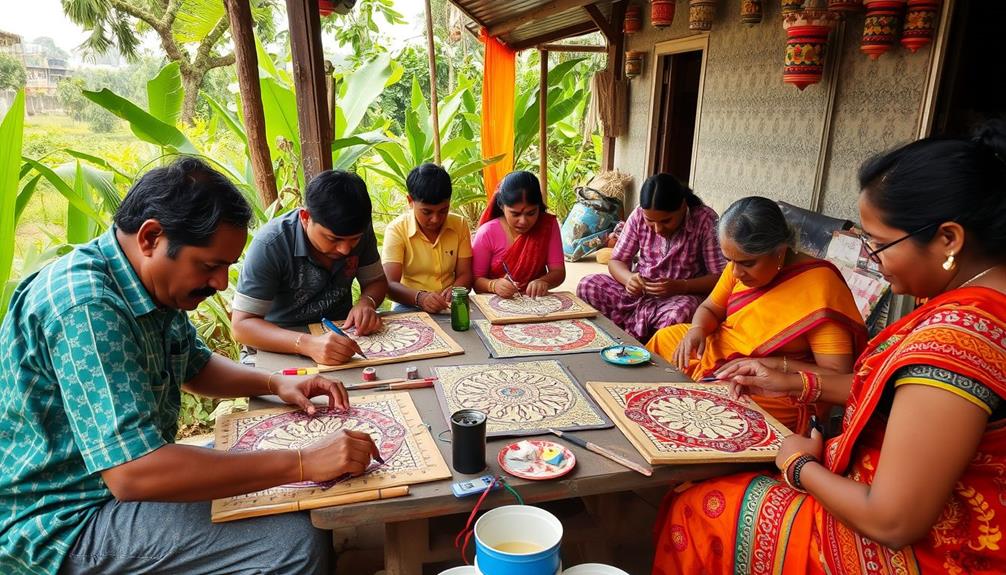
The future prospects for Bengal Pattachitra are bright, with artists actively embracing digital techniques and animation to reach global audiences. This traditional art form is gaining traction among future generations, spurring interest and engagement.
With the rise of virtual platforms, artists can participate in major national and regional hackathons that encourage innovative approaches to traditional crafts. Workshops and educational programs are popping up, teaching Pattachitra techniques and storytelling, ensuring that the skills are passed down and evolve with modern influences.
Cultural exchanges play a significant role, as collaborations with international artists enrich the Pattachitra tradition. These partnerships enable the fusion of contemporary styles while preserving the art's historical roots.
Increased participation in national and international art fairs and exhibitions boosts visibility, creating demand for Pattachitra artworks and offering sustainable livelihood opportunities for artists.
Support from government and non-governmental organizations is also essential. Their focus on preservation efforts and market development helps keep the art form relevant amid changing societal contexts.
As you witness this evolution, you can appreciate how Bengal Pattachitra isn't only maintaining its essence but also adapting to a global stage, ensuring that future generations can enjoy and contribute to this vibrant art form.
Frequently Asked Questions
What Is the Pattachitra of Bengal?
Pattachitra of Bengal is a vibrant folk art form, showcasing storytelling through intricate paintings on cloth. You'll find themes from mythology, folklore, and social issues, all depicted with bold colors and meticulous detail.
What Is the Pattachitra Theme Based On?
The Pattachitra theme's based on Hindu mythology, showcasing stories from the Ramayana and Mahabharata, local deities, and folklore. You'll see moral lessons and cultural values vividly illustrated through intricate designs and vibrant colors.
What Is the Traditional Folk Art of West Bengal?
You'll discover that the traditional folk art of West Bengal is a vibrant tapestry of storytelling. Its intricate designs and vivid colors breathe life into myths and social themes, enchanting hearts and minds with every brushstroke.
What Is the Meaning of Pattachitra in English?
Pattachitra translates to "cloth picture" in English, where "patta" means cloth and "chitra" means picture. This traditional art form features vibrant designs and serves as a storytelling medium through intricate paintings on cloth.
Conclusion
In exploring the Bengal Pattachitra tradition, you see how its rich history and vibrant techniques weave together community and culture. Despite facing contemporary challenges, such as declining demand, artists like Manik Sardar are adapting by incorporating modern themes into their work, ensuring relevance while preserving tradition. By supporting these artisans, you contribute to the survival of this unique art form, fostering a deeper appreciation for its heritage and artistic significance in today's world.
